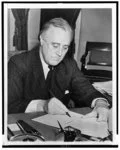Thanksgiving Hasn’t Always Been in November, Just Ask President James Madison
By Christopher Ringle
The American Thanksgiving tradition is as old as the nation itself. Most of us assume that Thanksgiving is always on the 4th Thursday of November. In fact, our first President, George Washington, started the tradition in 1789 when he proclaimed November 26th, the 4th Thursday, as the Thanksgiving holiday that year.
But did you know that until 1941, Presidents could proclaim any day of the year as Thanksgiving Day? That’s right, and there were some curious dates chosen for Thanksgiving between 1789 and 1941. Let’s take a look.
President Washington liked the idea of the Thanksgiving holiday set in late November. Farmers’ crops were usually gathered and stored, most citizens were prepared for winter, but snow was still infrequent in late November in most of the country. People could visit family, friends, or attend religious services as part of the Thanksgiving holiday.
John Adams, Washington’s successor, wanted to shake things up. He changed the title of the day from “Thanksgiving” to “A Day of Fasting and Humiliation.” Yes, you read that right. Adams believed that the day should not necessarily be a day filled with turkey, dressing, and pumpkin pie. Rather, it was a day to reflect, be prayerful and attend church. In other words, he viewed the day through a religious/spiritual point of view.
Adams also switched the dates for the holiday. He proclaimed Days of Fasting and Humiliation on Wednesday, May 9 in 1798 and Thursday, April 25 in 1799!
Thomas Jefferson, the President after Adams, didn’t want to issue a Thanksgiving proclamation at all! In fact, he didn’t support the tradition as an American holiday. Apparently, it wasn’t that he opposed holidays, or even opposed Thanksgiving for that matter. In fact, as Governor of Virginia, Jefferson had issued proclamations for Thanksgiving on a regular basis.
But now as U.S. President, Jefferson feared that a national holiday focused on Thanksgiving might give the appearance of the government’s endorsement of a religious holiday. Jefferson was for a strict separation of church and state and wanted to avoid even the appearance of the government favoring a religious holiday. His view may have been fueled by his predecessor’s (Adams’) heavily-religious approach to the holiday. So, Jefferson didn’t issue a Thanksgiving proclamation at all, but allowed states to do so if they wished.
The next President, James Madison, restored the Thanksgiving tradition. But he also demonstrated just how haphazard and unpredictable the date for Thanksgiving could be. In 1812, he picked Thursday, August 20th. The following year, it was Thursday, September 9th. In 1814, he chose a Thursday in January! Imagine a Thanksgiving in January!
Between Madison and Lincoln, states often selected their own Thanksgiving day. The New England states apparently had the strongest ongoing Thanksgiving traditions. U.S. Presidents during that time tended to proclaim the last Thursday in November as the official date for Thanksgiving. Of note, this holiday was still not regarded as a legal national holiday before 1861.
In the midst of the Civil War, President Lincoln declared Thanksgiving to be a national holiday on the last Thursday in November of 1863. On that occasion, Lincoln encouraged Americans to heal wounds and restore peace, tranquility and union.
After Lincoln’s assassination in 1865, President Andrew Johnson found himself so busy with post-war duties that he forgot to issue a Thanksgiving proclamation of any kind for 1865. A local church delegation reminded him, and he quickly issued a proclamation for December 7, 1865. He returned the date of Thanksgiving to late November for the rest of his term of office.
Presidents between Andrew Johnson and Franklin Delano Roosevelt (FDR) stuck to a tradition of the last Thursday in November. When FDR took office in 1933, Thanksgiving was still not a fixed legal holiday, but was left up to the sitting President to decide.
The first Thanksgiving of FDR’s term of office presented a big problem for him. Turns out there were five Thursdays in November in 1933. If he kept the holiday on the last Thursday it would be November 30th. Business leaders appealed to him to change the date since a Thanksgiving so late in November meant far fewer shopping days until Christmas! They claimed they couldn’t afford to lose that much business deep in the Great Depression. They urged him to move the holiday to Thursday the 23rd which would offer one more week between Thanksgiving and Christmas for shopping. FDR thought about it a lot and eventually decided that he’d keep the original November 30th date for tradition’s sake.
FDR faced the same problem in 1939 when Thanksgiving would again fall on November 30th and shorten the time between Thanksgiving and Christmas for gift shopping. Facing a re-election campaign the following year, FDR decided to yield to business leaders. He changed Thanksgiving to November 23rd that year. Several states loudly protested this change and kept Thanksgiving on November 30th, at least in their states. Several newspapers called FDR’s date change a “rabbit trick.” They scorned him for favoring a longer shopping season to the importance of the Thanksgiving holiday itself.
Congress finally decided to create a law setting the date of Thanksgiving. Congress made the 4th Thursday in November the legal holiday from then on. I’d note that they passed this law on December 26, 1941, only a few weeks after the US entered World War II. From that time on, Thanksgiving has been officially celebrated on the 4th Thursday of November.
© 2023. Christopher Ringle. All rights reserved.









